SBMA presents “The Artful Recluse“ featuring 17th-century Chinese paintings-many on view for the first time in the U.S.
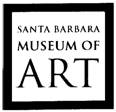
Contact:Katrina Carl
(805)884-6430
kcarl@sbma.net

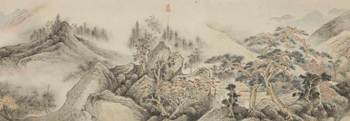
Shen Shichong, Landscape (detail), 1631. Handscroll, ink and color on paper. Private collection.
The Artful Recluse:
Painting, Poetry, and Politics in 17th-Century China
On View October 20, 2012 – January 20, 2013
“…Entering the mountain is not avoiding the world,
But a deep desire to be far from floating fame.
Streams and stones so blue-green,
Mists and evening clouds unleash my emotions…”
–Xiang Shengmo(1597-1658), Invitation to Reclusion
September 12, 2012 –The Santa Barbara Museum of Art(SBMA)presents a major exhibition of nearly 60 Chinese paintings that reveals the private world of the scholar-painters who lived during one of the most tumultuous periods of Chinese history―the end of Ming dynasty(c. 1600–1644)and the early years of foreign conquest by the Manchu-ruled Qing dynasty(1644–c.1700). Many of the paintings are exhibited for the first time in the United States, including a 20-foot-long masterpiece from the National Palace Museum, Taiwan(Republic of China). Drawn from six public institutions(plus SBMA)and seven private collections, the exhibition will be seen at only two venues:the Santa Barbara Museum of Art and the Asia Society in New York.
The Artful Recluse showcases some of China's most celebrated artists who, following a time-honored tradition in Chinese culture, withdrew from the treachery of a public life in politics to seek solace in nature, art, and private companionship. These artists created some of the most brilliant and diverse expressions in landscapes and other aspects of the natural world, including birds, flowers, and fish. Many of the paintings include poems and inscriptions that enhance the images with masterful calligraphy and offer, at the same time, a fascinating glimpse into the thoughts and emotions of the artists. Through painting and poetry, these artists asserted a new sense of self and voiced their responses to the times.
For some of these scholar-painters, like Dong Qichang(1555–1636)and Chen Jiru(1558–1639), reclusion meant engaging like-minded friends to study art and literature of the past, collecting art, and making art by evoking the ideas, styles, and brush manner of great masters. This intense focus on China’s literary and art-historical past resulted in flourishing developments in painting, as well as art theory, that influenced the development of art in the subsequent centuries and continues to affect the study of Chinese paintings to this day.

Chen Jiru, Thatched Hut by Tall Pines. Hanging scroll, ink on paper. Santa Barbara Museum of Art, Gift of N. P. Wong Family.
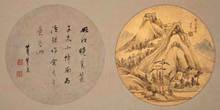
Dong Qichang, Landscapes (detail), n.d. Album of sixteen leaves, ink and color on gold paper. Private collection.
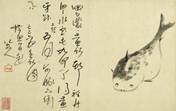
Bada Shanren, Golden Fish, Lotus Pods, Globefish, and Bamboo(detail), c.1689. Album of four leaves, ink or ink and color on paper. Private collection.
For other artists such as the monk Kuncan(1612–1673), worldly disengagement meant a strong commitment to Buddhism and to the Buddhist community, which played a significant role as both a physical and spiritual sanctuary for scholar-artists after the collapse of the Ming dynasty. Kuncan, like many artists, used images of nature to voice his distinct response to the loss of the country to foreign invaders. Others, such as Wang Yuanqi, exemplified the idea of maintaining the equilibrium of detachment despite being engaged in worldly affairs.
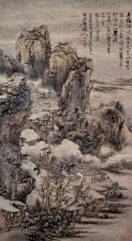
Kuncan,Temple on a Mountain Ledge, 1661. Hanging scroll, ink and color on paper. Asia Society, New York:Mr. and Mrs. John D. Rockefeller 3rd Collection, 1974.124. Courtesy of Asia Society, New York.
The exhibition is organized into two chronological sections―the late Ming and early Quing dynasties―and a number of sub-sections, including Summoning the Recluse, Reclusion in Art,Images of Self, Remnants and Loyalists, The Master of Hiding, andReclusion Reconfigured ―with the final section illustrating a return to dynastic stability. This tone is highlighted by a spectacular set of twelve, monumental hanging scrolls from the National Palace Museum, Taiwain(Republic of China)titledPlants of Virtue and Rocks by Water(Sketching Bamboo)by the famous individualist Shitao(1642–1707).
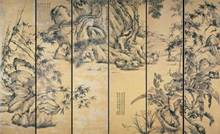
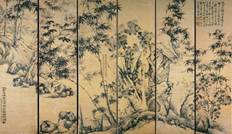
Shitao, Plants of Virtue and Rocks by Water(Sketching Bamboo),. Set of 12 hanging scrolls, ink on paper. The National Palace Museum, Republic of China, Taiwan. On view at SBMA only.
Susan Tai, Elizabeth Atkins Curator of Asian Art at the Santa Barbara Museum of Art, organized the exhibition and the accompanying catalogue, in collaboration with Peter Sturman, professor of History of Art and Architecture at the University of California, Santa Barbara. The catalogue is the first publication to explore in depth the theme of reclusion in painting and calligraphy within the broader context of political and social changes in the 17th century, and includes essays authored by leading scholars in the fields of art, literature, and history.
The Artful Recluse will also be on view at the Asia Society in New York, NY March 5 – June 2, 2013.
This exhibition is made possible through the generosity of China Guardian Auctions Co., Ltd.,SBMA Women’s Board, Robert and Mercedes Eichholz Foundation, in memory of F. Bailey Vanderhoef, Jr., Dr. Albert E. and Antoinette Gump Amorteguy Oriental Publications Endowment, Cecille and Michael Pulitzer Foundation, Victor K. Atkins, Jr., Natalia and Michael Howe, Siri and Bob Marshall, The Charles Bloom Foundation, The Rong-Wu Foundation, Capital Group, Inc. Oriental Lecture Fund Endowment, Robert and Christine Emmons, Bruce G. Wilcox, Chen Chite, Amy Chu-hua O’Dowd, Pamela Melone, The Metropolitan Center for Far Eastern Art Studies, Kyoto, E. Rhodes and Leona B. Carpenter Foundation, and the Santa Barbara Museum of Art’s Friends of Asian Art.
The Santa Barbara Museum of Art is a privately funded, not-for-profit institution that presents internationally recognized collections and exhibitions and a broad array of cultural and educational activities as well as travel opportunities around the world.
Santa Barbara Museum of Art, 1130 State Street, Santa Barbara, CA.
Open Tuesday - Sunday 11 am to 5 pm, Chase Free Thursday Evenings 5 – 8 pm
805.963.4364 www.sbma.net

















